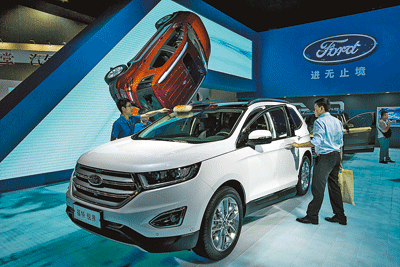
THE Central Government’s move to cut taxes on small-engine cars may revive sales growth in 2016 only to leave the world’s biggest auto market running on empty in years to come, analysts warn, raising the specter of industry restructuring at the end of the road.
On the eve of one of China’s biggest auto shows, opened in Guangzhou on Friday, sector watchers said sales may rise from 1-8 percent next year after the government cut taxes to coax buyers who had turned fretful over China’s slowing economic growth. The wide range of forecasts highlights the uncertainty now clouding China’s auto market and the tax cut’s impact.
The 2016 projections could mean improvement on the 2 percent growth seen for this year. Yet many analysts see the tax cut as “pulling forward” future car sales, and are lowering forecasts for 2017 and 2018 towards a single-digit percentage level that they say may force carmakers and the government to embrace a shake-out.
“China would have then no choice but to allow some painful restructuring to occur,” said John Humphrey, a senior analyst for JD Power. Three or more years with growth “around 2 or 3 or 4 percent” would render the status quo of government support through times of weaker sales growth “untenable,” Humphrey said.
Benefiting from decades of double-digit percentage sales growth as it rose from humble beginnings, China’s auto sector has yet to experience significant restructuring.
At times when China’s carmakers have run into temporary sales dips, the government has stepped in with policy support, such as tax cuts and purchase subsidies. With the economy slowing, squeezing the government of tax revenue, automakers wouldn’t be able to count on further policy support, analysts say.
The latest tax cut — on vehicles with 1.6 liter or smaller engines — was introduced Oct. 1 after sales had threatened to slip into negative territory as the economy faltered.
Authorities similarly cut taxes in 2009 to boost car sales, only to see a negative correction once the breaks expired, said John Zeng, an analyst for LMC Automotive Consulting.
LMC raised its 2016 forecast for passenger vehicle growth to 8.2 percent after October’s move, but lowered its sales forecast for next two years. It now sees 2017 growth at 4.5 percent.
Carmakers have yet to pull back on long-term production and investment plans in China, but have already used up some firepower in seeking to support sales.
Companies like Volkswagen AG and General Motors Co. already cut prices this year and are reducing production shifts.
Meanwhile domestic firm Guangzhou Automobile Group delayed adding 400,000 in new car production capacity, the first half of which was to come on line next year, to 2020.(SD-Agencies)
|

